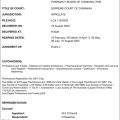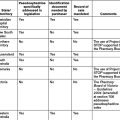Chapter 12 Occupational health and safety
INTRODUCTION
The legislative framework at Commonwealth, state and territory levels provides for the various systems of occupational health and safety regulation. The legislation is set out in Table 12.1.
| Commonwealth | Occupational Health and Safety (Commonwealth Employment) Act 1991 |
|---|---|
| ACT | Occupational Health and Safety Act 1989 |
| NSW | Occupational Health and Safety Act 2000 |
| NT | Work Health Act 1991 |
| QLD | Workplace Health and Safety Act 1995 |
| SA | Occupational Health, Safety and Welfare Act 1986 |
| Tas | Workplace Health and Safety Act 1995 |
| Vic | Occupational Health and Safety Act 2004 |
| WA | Occupational Safety and Health Act 1984 |
It is worthy of note that in 2008, an inter-governmental agreement for Regulatory and Operational Reform in Occupational Health and Safety was signed between the federal, state and territory governments. While the present laws are based on similar underlying principles, it was recognised that there were still differences between the jurisdictions in the details and application of these laws. The Council of Australian Governments agreed to work to harmonise occupational health and safety legislation according to the principles and processes outlined in the document.
OBLIGATIONS AND RESPONSIBILITIES OF THE EMPLOYER
The employer is obliged to identify and control any risks to safety that are, or may be, present in a workplace. That is, the legislation imposes a positive and proactive obligation on the employer to identify hazards, and then to undertake a risk analysis with the aim of eliminating or controlling hazards in the workplace. In pursuit of this objective, employers in all jurisdictions have access to authorities established to assist in the development of codes of practice that aim to provide safe working environments.[5] A failure by an employer or self-employed individual to abide by such a code may be used as evidence of a failure to provide a safe system or safe place of work. Codes of practice and national standards are also provided by the Australian Safety and Compensation Council (ASCC), which was established under the Australian Workplace Safety Standards Act 2005 (Cth). It should be noted however, that these codes are advisory documents only and do not carry any legislative or regulatory force. The ASCC has, as part of its membership, representatives from the federal, state and territory governments together with representatives from employer and employee organisations.
OBLIGATIONS AND RESPONSIBILITIES OF EMPLOYEES
Should an employee become aware of an imminent threat to their health and safety, or the health and safety of others, they have a duty to take reasonable measures to ensure both their safety and the safety of others. In such circumstances an inspector may also order the cessation of work. (For information on inspectors see the section under ‘Compliance’ in this chapter.)
HEALTH AND SAFETY REPRESENTATIVES
In all jurisdictions, other than the Northern Territory, employees have the right to elect a health and safety representative. Under the respective legislation[6] a health and safety representative may take time away from work for training, have access to certain categories of information, inspect workplaces, accompany official inspectors, make inquiries into accidents, require an employer to establish a health and safety committee and accompany inspectors and employees engaged in interviews on health and safety matters. They are empowered, under Commonwealth, ACT, South Australian and Victorian legislation, to issue Provisional Improvement Notices or Default Notices identifying that there has been a breach of the Occupational Health and Safety Act of that jurisdiction and some action needs to be taken. It is a requirement in such circumstances that a notice of the breach is displayed within the workplace and reasonable steps are taken to remedy the identified breach.
Staff–management committees
However, it is not the role of these committees to assume responsibility for the health and safety of the workforce as this responsibility remains with the employer.
PROTECTION OF WORKERS INVOLVED IN OCCUPATIONAL HEALTH AND SAFETY ACTIVITIES
Employer not to dismiss etc. employee on certain grounds
Note: An employer who breaches this section may be subject to civil action.
Compliance
In the respective jurisdictions a breach of the occupational health and safety legislation may constitute an offence. The particular legislative provisions in the jurisdiction in which the offence occurred will determine whether there has been a breach, and the appropriate outcome of that breach. Monetary penalties in the form of a fine will generally apply where there is a failure to comply with the recording and/or reporting requirements as set out under the legislation; however, in some circumstances a term of imprisonment may be applied. Where there has been a death of a person, workplace criminal provisions apply. All states and territories have in place specific provisions under the occupational health and safety legislation that create penalties in respect of the death of a worker in the course of their employment. In addition, the criminal law also creates the crime of manslaughter. The Crimes (Industrial Manslaughter) Amendment Act 1903 (ACT) which amends the Crimes Act 1900 (ACT) creates an offence of ‘industrial manslaughter’. Part 2A ensures that where the conduct of an employer, or a senior officer of the employer, causes the death of a worker they can be held responsible where they were ‘reckless about causing serious harm to the worker … [or] negligent about causing the death of the worker’ (s49C). ‘Conduct’, under the Act, includes omissions and the offence is punishable by imprisonment for up to 20 years.
OCCUPATIONAL HEALTH AND SAFETY AND MEDICINES OF A HAZARDOUS NATURE
One area of pharmacy practice of particular relevance to occupational health and safety issues is the preparation of medicines of a hazardous nature. Medicines exhibiting one or more of the following properties in humans or animals — carcinogenicity, teratogenicity, reproductive toxicity, organ toxicity at low doses and/or genotoxicty — are considered hazardous.[7] The most commonly used medicines so recognised are the antineoplastic agents (cancer chemotherapy drugs, cytotoxic drugs). While these agents pose a significant risk to patients because of their high cell toxicity, mainly through the action on cell reproduction, there are also significant risks to health workers and the environment. There is little argument with the premise that health practitioners preparing or administering antineoplastic agents run a very real risk of contaminating not only themselves, but also the environment if proper precautions are not taken.[8, 9, 10, 11, 12]
2. Occupational Health and Safety (Commonwealth Employment) Act 1991 (Cth)
3. Occupational, Health, Safety and Welfare Act 1986 (SA)
4. Occupational Health and Safety Act 1989 (ACT)
5. Cth: Safety, Rehabilitation and Compensation Commission; WA: WorkSafe Western Australia; SA: SafeWork SA Advisory Committee; NT: Work Health Authority; Vic: WorkCover Authority; Tas: WorkCover Tasmania; ACT: Occupational Health and Safety Council; NSW: WorkCover Authority; Qld: The Minister’s Office
6. Occupational Health and Safety (Commonwealth Employment) Act 1991 (Cth); Occupational Health and Safety Act 1989 (ACT); Occupational Health and Safety Act 2000 (NSW); Workplace Health and Safety Act 1995 (Qld); Occupational Health Safety and Welfare Act 1986 (SA); Workplace Health and Safety Act 1995 (Tas); Occupational Health and Safety Act 2004 (Vic); Occupational Health and Safety Act 1984 (WA)
7. National Institute of Occupational Safety and Health Alert. Preventing occupational exposures to antineoplastic and other hazardous drugs in health care settings. Online. Available: www.cdc.gov/niosh/docs/2004-165/ [accessed 17 March 2009.
8. Ahlborg G., Hemminki K. Reproductive effects of chemical exposures in health professionals. Journal of Occupational and Environmental Medicine. 1995;37:957-961.
9. Sorsa M., Anderson D. Monitoring of occupational exposure to cytostatic anticancer agents. Mutation Research. 1996;355:253-261.
10. Fransman W. Occupational exposure to cytotoxic drugs. Hospital Pharmacy Eur. 2007;35:85-86.
11. Connor T.H., McDiarmid M.A. Preventing occupational exposures to antineoplastic drugs in health care settings. CA: A Cancer Journal for Clinicians. 2006;56:354-365.
12. Rodriquez P., Yap C.Y. Abnormal blood results found in pharmacists preparing cytotoxics [letter]. Australian Journal of Hospital Pharmacy. 1991;21:39.
13. Standards Association of Australia (SAA). Committee on Controlled Environments. Australia standard AS2567: Laminar flow cytotoxic drug safety cabinets. Sydney: SAA; 2002.
14. Standards Association of Australia (SAA). Committee on Controlled Environments. Australia standard AS4273: Design, installation and use of pharmaceutical isolators. Sydney: SAA; 1999.
15. Standards Association of Australia. Committee on Controlled Environments. Australia standard AS2639: Laminar flow cytotoxic drug safety cabinets — installation and use. Sydney: SAA; 1994.
16. Standards Association of Australia (SAA). Committee on Controlled Environments. Australia standard AS1386.5: Cleanrooms and clean workstations. Sydney: SAA; 1989.
17. Standards Association of Australia (SAA). Committee on Controlled Environments. Australia standard AS1807.22. Cleanrooms, workstations, safety cabinets and pharmaceutical isolators — methods of test — determination of air barrier containment of laminar flow cabinets. Sydney: SAA; 2000.
18. Standards Association of Australia (SAA). Committee on Occupational Respiratory Protection SF-010. Australian standard AS/NZS 1716: Respiratory protection devices. Sydney: SAA; 2003.
19. The Society of Hospital Pharmacists of Australia Committee of Specialty Practice in Oncology. Standards of practice for the provision of clinical oncology pharmacy services 2002. Journal of Pharmacy Practice and Research. 2002;32(2):115-118.
20. The Society of Hospital Pharmacists of Australia Committee of Specialty Practice in Oncology. Standards of practice for the safe handling of cytotoxic drugs in pharmacy departments, August 2004. Pharm Pract Res. 2005;35(1):44-52.
21. The Society of Hospital Pharmacists of Australia Committee of Specialty Practice in Oncology. Standards of practice for the transportation of cytotoxic drugs from pharmacy departments, August 2007. J Pharm Pract Res. 2007;37(3):234-235.
22. The Society of Hospital Pharmacists of Australia Committee of Specialty Practice in Oncology. Standards of practice for the provision of oral chemotherapy for the treatment of cancer, May 2007. J Pharm Pract Res. 2007;37(2):149-152.





